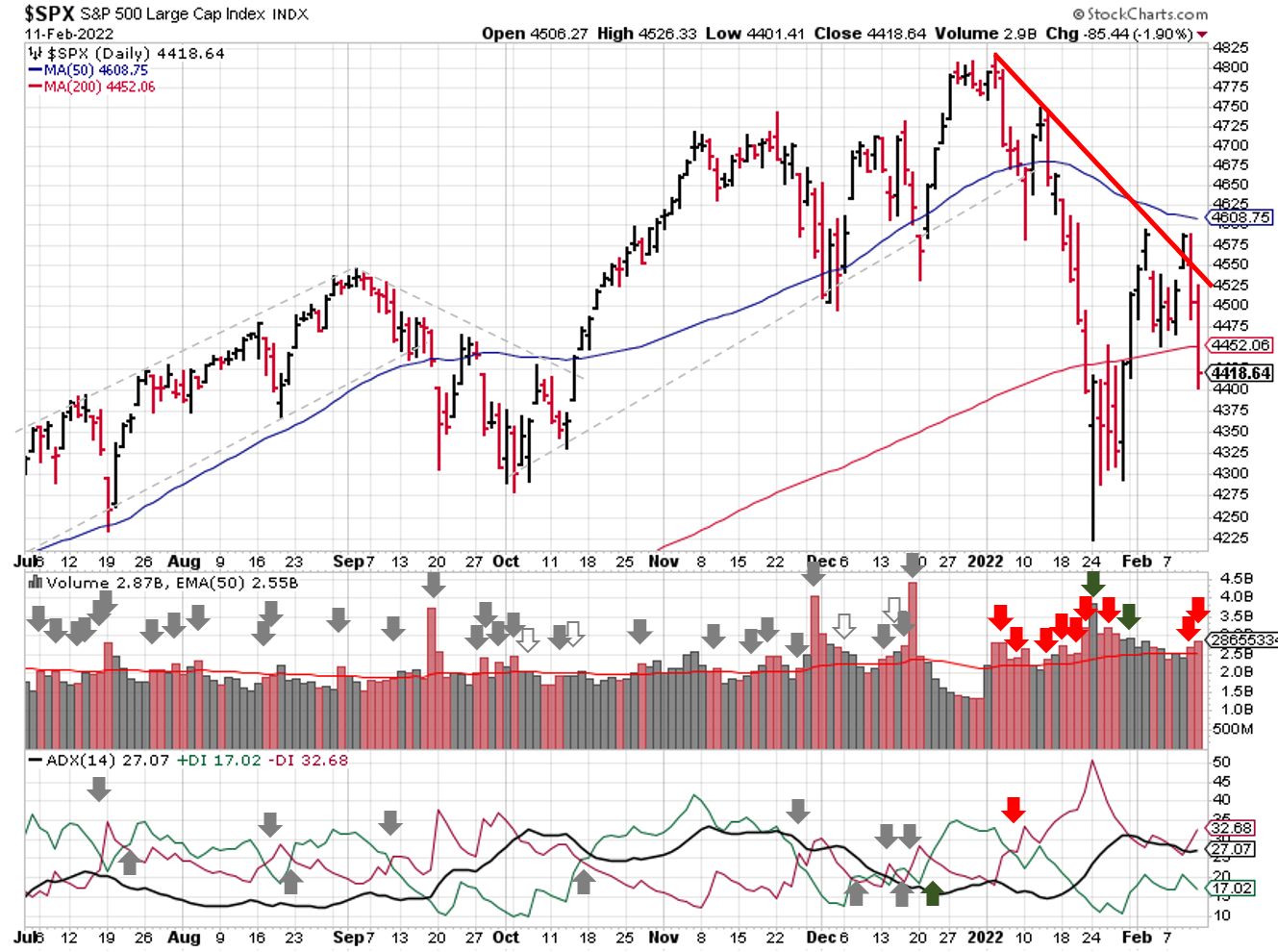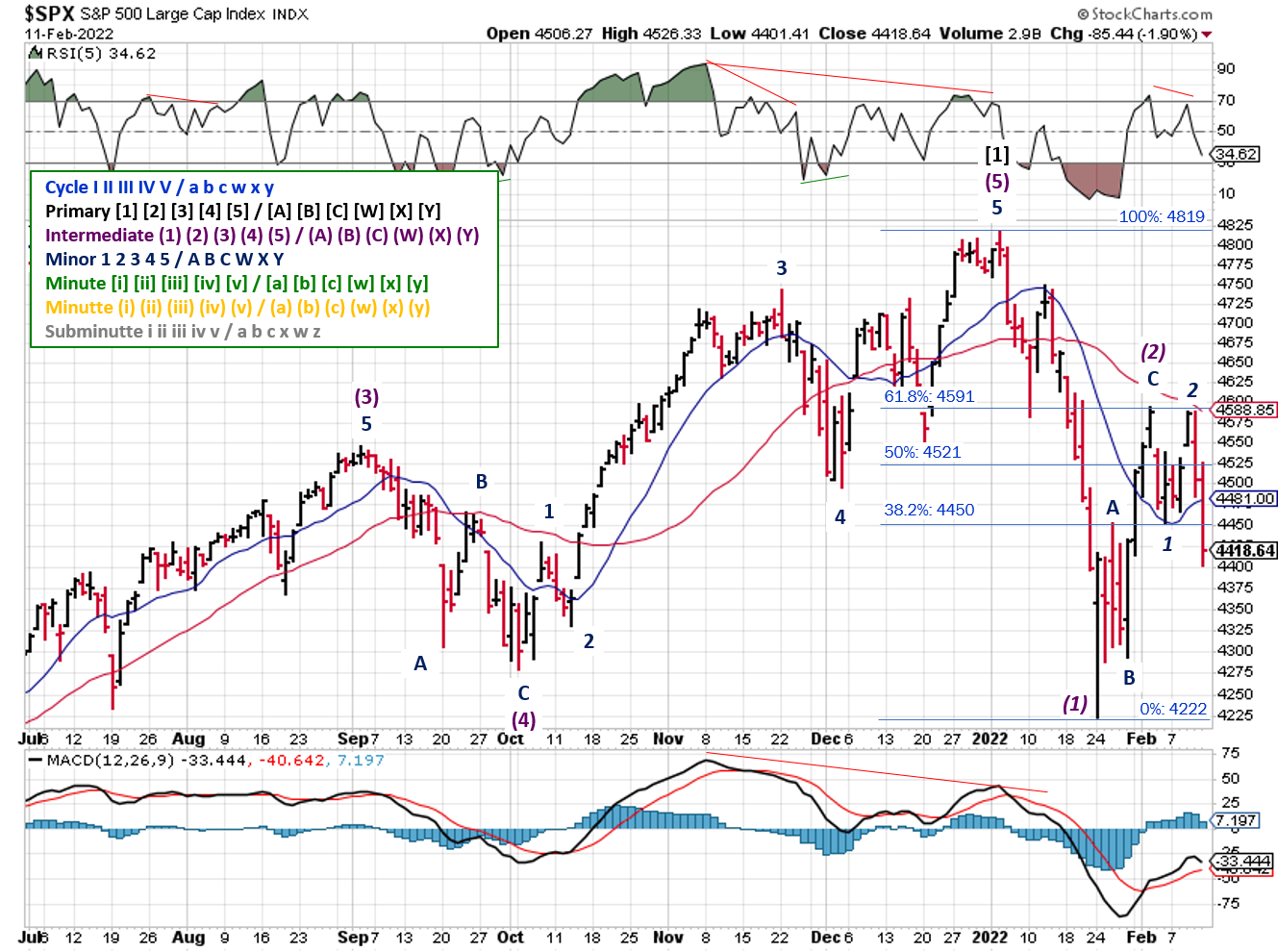Stock Market Outlook
For The Week Of February 13th = Downtrend
INDICATORS
-
ADX Directional Indicators: Downtrend
Price & Volume Action: Downtrend
Elliott Wave Analysis: Downtrend
The S&P500 ($SPX) tried to rally back to the 50-day moving average, and briefly got past the downward trendline. But the initial move was no match for the latest inflation report, which sent stocks back below the 200-day moving average.
2022-02-13-SPX Trendline Analysis - Daily
The ADX remains bearish. The price/volume signal moved back to a downtrend, as the index sliced through the 200-day moving average on higher volume. Friday's close also put the index back below the Jan 21st follow-through day.
2022-02-13-SPX Elliott Wave Analysis - Daily - Primary 2
The Elliott Wave signal remains bearish as well. The SPX tried to break through resistance at the 61.8% Fibonacci level of Intermediate (1) on Wednesday and Thursday, but retreated on both attempts. On Friday, the index fell farther, losing support at the 38.2% Fibonacci level.
COMMENTARY
Following January's surprise jobs report, January's consumer price index also surprised to the upside, showing a 7.5% increase year over year, above the 7.3% expectation. Core CPI (which excludes food and energy) was still up 6%.
Those readings sent yield on the 10-year Treasury past 2% for the first time since 2019. And as expected, rate sensitive stocks took a nose dive (we see you $QQQ). St. Louis Fed President Bullard added fuel to the fire by calling for raising interest rates by 1% by the end of June.
While it's highly likely that we're at the peak of y-o-y inflation readings, it's also highly likely that the price increases we've seen over the past year are going to be around for a while (i.e. they're sticky).
The next policy meeting occurs in March (15th-16th). On Friday (Feb 10th), the Board announced a closed door meeting, taking place under "expedited procedures", to take place tomorrow (Monday, Feb 14). There's speculation that this is an emergency meeting to raise interest rates, in response to the higher than expected CPI numbers.
We know that interest rates are headed higher. Now we need to watch GDP releases. Slowing growth and rising rates are the land of bear markets; next release is Feb 24th.
We're also coming off the highest level of margin debt ever (as a percent of GDP); higher than the peak in 2000, 2008, and 2018. With rates set to rise, margin debt is about to get more expensive. And the sectors benefiting the most from margin on the way up will be the ones punished on the way down.
Hopefully, you've used the run-up to reallocate your holdings, book longer-term gains and cut your losses. At the very least, now is not the time to go all in. The markets will get back into bull mode eventually (they always do).
And let's not overlook the current situation in Ukraine. Hopefully cooler heads prevail.
Best To Your Week!
If you find this research helpful, please tell a friend. If you don't find it helpful, tell an enemy.
I regularly share articles and other news of interest via on Twitter (@investsafely), Facebook, Linkedin, and Instagram (@investsafely)

How to Make Money in Stocks: A Winning System in Good Times and Bad.
It's one of my favorites.
Invest Safely, LLC is an independent investment research and online financial media company. Use of Invest Safely, LLC and any other products available through invest-safely.com are subject to our Terms of Service and Privacy Policy. Not a recommendation to buy or sell any security.
Charts provided courtesy of stockcharts.com.
For historical Elliott Wave Analysis, go to ELLIOTT WAVE lives on by Tony Caldaro. Other interpretations can be found at: Pretzel Logic, and 12345ABCDEWXYZ
Once a year, I review the market outlook signals as if they were a mechanical trading system, while pointing out issues and making adjustments. The goal is to give you to give you an example of how to analyze and continuously improve your own systems.
- 2015 Performance - Stock Market Outlook
- 2016 Performance - Stock Market Outlook
- 2017 Performance - Stock Market Outlook
- 2018 Performance - Stock Market Outlook
- 2019 Performance - Stock Market Outlook
- 2020 Performance - Stock Market Outlook
IMPORTANT DISCLOSURE INFORMATION
This material is for general communication and is provided for informational and/or educational purposes only. None of the content should be viewed as a suggestion that you take or refrain from taking any action nor as a recommendation for any specific investment product, strategy, or other such purpose. Certain information contained herein has been obtained from third-party sources believed to be reliable, but we cannot guarantee its accuracy or completeness.
To the extent that a reader has any questions regarding the applicability of any specific issue discussed above to his/her individual situation, he/she is encouraged to consult with the professional advisors of his/her choosing. Invest Safely, LLC is not a law firm, certified public accounting firm, or registered investment advisor and no portion of its content should be construed as legal, accounting, or investment advice.
The material is not to be construed as an offer or a recommendation to buy or sell a security nor is it to be construed as investment advice. Additionally, the material accessible through this website does not constitute a representation that the investments described herein are suitable or appropriate for any person.
Hypothetical Presentations:
Any referenced performance is “as calculated” using the referenced funds and has not been independently verified. This presentation does not discuss, directly or indirectly, the amount of the profits or losses, realized or unrealized, by any reader or contributor, from any specific funds or securities.
The author and/or any reader may have experienced materially different performance based upon various factors during the corresponding time periods. To the extent that any portion of the content reflects hypothetical results that were achieved by means of the retroactive application of a back-tested model, such results have inherent limitations, including:
Model results do not reflect the results of actual trading using assets, but were achieved by means of the retroactive application of the referenced models, certain aspects of which may have been designed with the benefit of hindsight
Back-tested performance may not reflect the impact that any material market or economic factors might have had on the use of a trading model if the model had been used during the period to actually manage assets
Actual investment results during the corresponding time periods may have been materially different from those portrayed in the model
Past performance may not be indicative of future results. Therefore, no one should assume that future performance will be profitable, or equal to any corresponding historical index.
The S&P 500 Composite Total Return Index (the "S&P") is a market capitalization-weighted index of 500 widely held stocks often used as a proxy for the stock market. Standard & Poor's chooses the member companies for the S&P based on market size, liquidity, and industry group representation. Included are the common stocks of industrial, financial, utility, and transportation companies. The S&P is not an index into which an investor can directly invest. The historical S&P performance results (and those of all other indices) are provided exclusively for comparison purposes only, so as to provide general comparative information to assist an individual in determining whether the performance of a specific portfolio or model meets, or continues to meet investment objective(s). The model and indices performance results do not reflect the impact of taxes.
Investing involves risk (even the “safe” kind)! Past performance does not guarantee or indicate future results. Different types of investments involve varying degrees of underlying risk. Therefore, do not assume that future performance of any specific investment or investment strategy be suitable for your portfolio or individual situation, will be profitable, equal any historical performance level(s), or prove successful (including the investments and/or investment strategies describe on this site).




